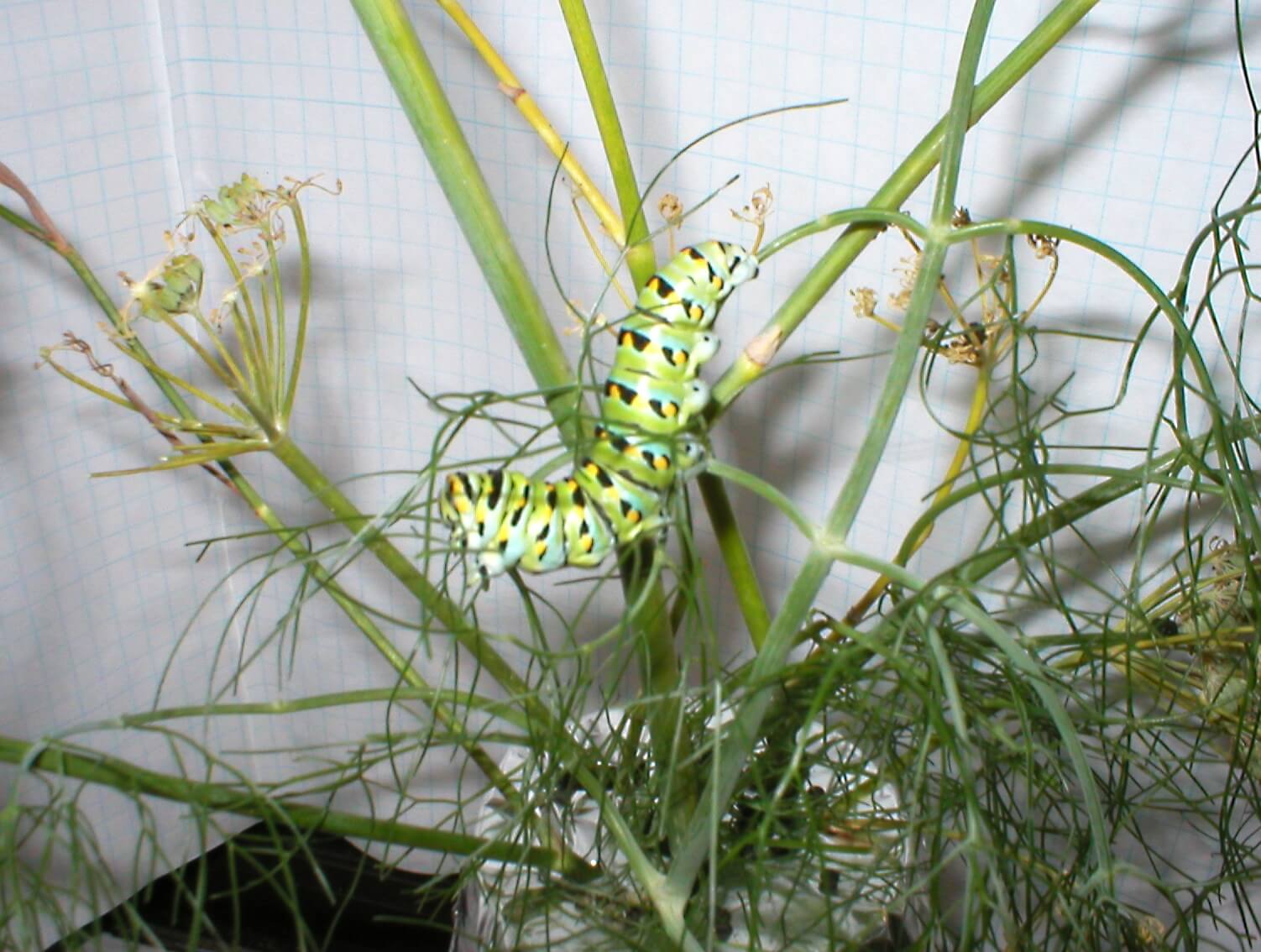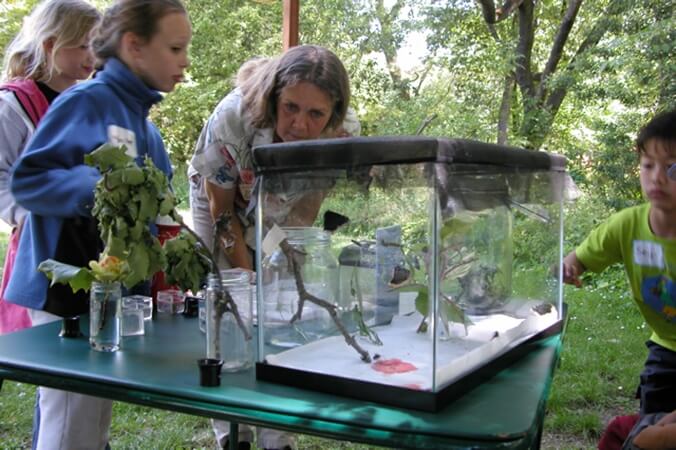Before bringing caterpillars (larvae) into your home or classroom be sure that you know what species of butterfly they are and what their larval host plant is, and be sure that you will have an ample supply of fresh host plant material to raise them through all the instars.
When deciding to ‘capture’ a creature like this, and to bring it indoors for close observation, please make every attempt to try to replicate the ‘habitat needs’ of the animal. Caterpillars live and feed on plants; they do not naturally live in confined spaces and they will not thrive on a few leaves tossed into an enclosed space. They need to be eating foliage that is still attached to a plant, or at the very least, a stem of their host plant with leaves attached. They do not feed on fallen leaves or off the ground.
Here’s what you will need to successfully raise a caterpillar indoors to the pupal and adult stage:
1 – an ample supply of the fresh host plant
2 – a dry tank (at least 10 gallons)
3 – a screen cloth cover that is tightly secured with an elastic band – do not use a sliding screen cover!
4 – clean paper towels to cover the bottom
5 – dry twigs for molting and pupating on
To assure fresh plant material you can use flower tubes (the type used by florists) to hold cuttings of the larval host plant. The flowers tubes can be placed in a small jar to hold them upright, but the drawback is that they have to be refilled with water daily to keep plant cuttings turgid. Or you can cover a jar with a double layer aluminum foil, fill it with water, and then poke holes through which the cut stems can be placed. Both these methods avoid accidental drowning of larvae.
For the Monarchs, Mexican or ‘tropical’ milkweed (Asclepias curassavica) can be grown to a good size in a 4” pot, and these can then be placed directly into a tank to provide for the larvae. Two or three plants will be necessary to support each larva. Place aluminum foil or a saucer under each pot so that it doesn’t leak through to the bottom of the tank when you water it. The bottom of the tank needs to stay dry, and paper towels on the bottom need to be reasonably clean.
Milkweeds are still viable plants even after the larvae have eaten all or most of the leaves; they can be cut back a bit to neaten their appearance, planted in a larger container and fertilized to induce vigorous new growth, or planted in a garden bed.
Make sure that no insecticides, especially systemics, are (or have been) used on the plants you use to feed your larvae, or anywhere close to where the larva is being kept. Some household cleaning products are also toxic or have harmful fumes that can have a damaging effect on a larva.
During the earliest instars, the larvae pretty much stay right on the host plant; they don’t necessarily need to be within a tank in this early stage. They may molt right on the plant, or move a short distance away. The molting process can take a day or two, and the larva won’t move much or feed during this period. Sometimes the larva will move to an edge of the pot or to the glass sides of the tank to molt. They spin a little silk pad to molt on, which gives them better traction when they need to ‘walk out’ of the old skin. The old skin (exuvia) is usually eaten, thus recycling useful nutrients. For later stages, you will want to create a contained environment.
A ten to twenty-gallon fish tank works well. Cut a screen cloth cover (the plastic type used for screen doors), holding it tightly in place with an elastic band. Do not use a sliding screen top! The larvae will sometimes choose to pupate on the screen, and depending on where they affix themselves, the screen may no longer slide open.
Line the bottom of the tank with paper towels and plan to clean it regularly. Don’t let the bottom of the tank become really dirty or damp; this can promote harmful bacterial or fungal growth that can be unhealthy for the larvae.
Place several twigs in upright or tilted positions inside the container. This provides additional places for the larva to pupate on, and places for the newly eclosed butterfly to hang on to. Keep the tank in a bright light situation but avoid placing the tank right next to a hot sunny window, as this can greatly intensify the heat, creating a harmful situation for the larvae.
Avoid handling the caterpillars. These are delicate creatures with soft bodies and permeable skins, and it is very easy to inadvertently harm them. Larvae breathe through ‘spiracles’, which are small openings along each side of their bodies; oils and lotions from human skin can clog up these breathing holes if they are handled too often. To move the larva onto a new plant (or plant cutting) when more food is necessary, either cut the leaf or a section of plant the larva is resting or feeding on and place it – larva and all – onto the new plant, or place the fresh plant so that some part of it touches the old, already consumed plant. The caterpillar will crawl by itself onto the new plant to feed.
If you have to move a larva that is not on plant material, use a soft artist’s brush to pick up or gently push the larva onto a piece of paper so that you can move it to the host plant.
As the time to pupate draws close, the caterpillar will often go into a wandering mode. If you pay close attention to the development of the larva and have been observing the molts, you can anticipate when the larva is ready to pupate. Most larvae go through five molts (and five instars), with the last molt revealing the pupa beneath. The consistency of the droppings (frass) often changes from dry and blackish to something much greener and moister just before the larva starts to look for a place to pupate.
Caterpillars can move a long way from the host plants before finding a safe and protected spot to pupate. Most butterfly caterpillars will spin a ‘silk button’ to attach to and will hang upside down, often in a soft ‘J’ shape, while undergoing their last molt. The Swallowtails pupate head side up, attached with both a silk button and a ‘girdle’ to the pupating site.
This last molting process can take a full day or more. Once the pupa has formed, the old skin splits and the pupa is revealed underneath. The pupa is soft, not fully colored, and looks mal-formed at first. Even though the caterpillar is now basically ‘cellular soup’ there’s a lot of wriggling going on for about half an hour until the pupa becomes the right shape and hardens. After that, the gold specks also appear on the lovely pale green pupa of the Monarch butterfly.
When the butterfly is nearing emergence (eclosure) the pupa darkens and you can often see the wing colors inside. Upon eclosure from the pupae, the butterfly’s abdomen is swollen with fluids and the wings are really tiny and folded. In some species you will see a bright red spot that looks like blood underneath the newly eclosed adult; this is meconium – a waste product of the process of metamorphosis.
The first thing the adult butterfly does upon emergence is to pump fluids into the veins of the wings. This expands the wings to their full size and shape, but the wings then need to dry and harden for flight. The butterfly must hang onto something, unobstructed, during this period; they cannot successfully expand their wings on a flat surface. The adult butterfly also needs to ‘knit’ two separate sides of their proboscis together to create feeding tube using their front legs. These processes can be observed, and if either fails to be successfully completed, the adult butterfly will not live to reproduce.
The adult butterfly ecloses from the pupa with a ‘fat pack‘ which will sustain it for about two days. Plan to release your butterfly on a calm, warm, and sunny day; mid-morning is best, so that the butterfly has time to feed and find a safe night-time roost. Be sure to release your butterfly in the same type of environment or plant community that you found it in.
In nature, of the four to seven hundred eggs laid by each female, just one or two actually survives all the risks and makes it to the adult stage! The risks are many; eggs are eaten by all sorts of other insects, spiders, and birds. Caterpillars are also fair game; even those like the Monarch, that sequester toxic compounds in their bodies and exhibit warning colorations, are occasionally eaten by birds. Larvae are also eaten by small mammals, and they can also be parasitized. The pupa also has predators; sometimes you can see a neat hole drilled in one and the contents sucked out. Large carnivorous wasps can do this.
Once you have created a thriving butterfly garden with drifts of larval host plants, you can also raise butterflies from their eggs. It takes sharp eyes to find these tiny pearls; most butterfly species lay their eggs singly, and often on the protected undersides of a leaf, or in amongst the flowers buds.
Please do not ever purchase commercially raised larvae or butterflies. The creatures are usually raised in labs under very unnatural conditions that provide fertile ground for the spread of disease. Releasing farmed organisms into wild populations often lowers the genetic fitness of a species, and in migrating species such as the Monarch, can also interfere with the individual creature’s ability to migrate properly. Commercial operations will often sell the larvae when there is an insufficient supply of the host plant available, and when few nectar-producing plants are ready to sustain the adults.
The whole process of metamorphosis is an amazing thing to witness, and there is so much to be learned by careful study and observation. A loupe or magnifying glass adds still another dimension. Carefully observing the process of metamorphosis helps develop an understanding and appreciation of the complexity of the web of life upon which we all depend.
These wonderful creatures, these ‘jewels on the wing’, are symbolic of all that is beautiful and free in nature, so raising and releasing a healthy, vigorous butterfly is cause for celebration!
Raising Mourning Cloak butterflies with the kids at MAGC.



